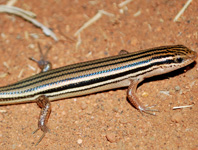Abstract
Two new species of Parameiropsis are herein described that were identified from the Korean Deep Ocean Study (KODOS) in the Clarion–Clipperton Fracture Zone, located in the eastern central Pacific. Parameiropsis kodosensis n. sp. is similar to P. magnus Itô, 1983 in two key respects: the presence of a distal seta on the syncoxa of the maxilliped, and the general features of its swimming legs. However, P. kodosensis can be differentiated from P. magnus by a higher length-to-width ratio of the caudal ramus (2.5:1 and 1:1 respectively), the setal number on the exp-3 of P1, and the exp and benp of P5 are separated in P. kodosensis, while they are fused in P. magnus. Parameiropsis tetraspinosa n. sp. resembles P. peruanus Becker, 1974 in the absence of a fused seta in the outermost spine on the endopod of antenna and the general features of the swimming legs. However, P. tetraspinosa can be distinguished from P. peruanus by a higher length-to-width ratio of the caudal ramus (3.9:1 and 2.3:1 respectively), the presence of a distal seta on the syncoxa of the maxilliped, and by its medially fused P5. In this study full descriptions and a comparison with previously described species are provided. Additionally, a key to females of Parameiropsis species is given.
References
Becker, K.H. (1974) Eidonomie und Taxonomie abyssaler Harpacticoidea (Crustacea, Copepoda). Teil I. Cerviniidae–Ameiridae. Meteor Forschungs–Ergebnisse, 18D, 1–28.
Brady, G.S. (1880) A Monograph of the free and semi-parasitic Copepoda of the British Islands, 2. The Ray Society, London, 182 pp.
Boxshall, G.A. & Halsey, S.H. (2004) An Introduction to Copepod Diversity. The Ray Society, London, 966 pp.
Corgosinho, P.H.C. & Gheerardyn, H. (2009) A new species of Parameiropsis Becker, 1974 (Copepoda: Harpacticoida) from the Porcupine Seabight (North-East Atlantic Ocean). Marine Biodiversity, 39, 83–93.
http://dx.doi.org/10.1007/s12526-009-0005-8Corgosinho, P.H.C. & Martínez Arbizu, P. (2010) Ameiridae Boeck and Argestidae Por revisited, with establishment of Parameiropsidae, a new family of Harpacticoida (Crustacea, Copepoda) from deep-sea sediments. Helgoland Marine Research, 64, 223–254.
http://dx.doi.org/10.1007/s10152-009-0185-4Gee, J.M. (2009) Some new and rare species of Ameiridae (Copepoda: Harpacticoida) from the Isles of Sicily, UK. Journal of Natural History, 43, 2809–2851.
http://dx.doi.org/10.1080/00222930903373991Huys, R. & Boxshall, G.A. (1991) Copepod Evolution. The Ray Society, London, 468 pp.
Itô, T. (1983) Harpacticoid copepods from the Pacific abyssal off Mindanao. II. Cerviniidae (cont.), Thalestridae, and Ameiridae. Publications of the Seto Marine Biological Laboratory, 28, 151–254.
Lang, K. (1944) Monographie der Harpacticiden (Vorläufige Mitteilung). Almqvist & Wiksells, Uppsala, 39 pp.
Lang, K. (1948) Monographie der Harpacticiden,1–2. Nordiska Bokhandeln, Lund, 1682 pp.
Lee, W. & Huys, R. (2002) A new genus of groundwater Ameiridae (Copepoda, Harpacticoida) from boreholes in Western Australia and the artificial status of Stygonitocrella Petkovski, 1976. Bulletin of the Natural History Museum, London. Zoology Series, 68, 39–50.
Menzel, L. (2011) First descriptions of copepodid stages, sexual dimorphism and intraspecific variability of Mesocletodes Sars, 1909 (Copepoda, Harpacticoida, Argestidae), including the description of a new species with broad abyssal distribution. Zookeys, 96, 39–80.
http://dx.doi.org/10.3897/zookeys.96.1496Menzel, L., George, K.H. & Martínez Arbizu, P. (2011) Submarine ridges do not prevent large-scale dispersal of abyssal fauna: A case study of Mesocletodes (Crustacea, Copepoda, Harpacticoida). Deep-Sea Research I, 58, 839–864.
http://dx.doi.org/10.1016/j.dsr.2011.05.008MOF (2014) Annual report on the exploration activities of the government of the Republic of Korea in 2013. Ministry of Oceans and Fisheries, Korea, 127 pp.
Rademaekers, K., Widerberg, O., Svatikova, K. & van der Veen, R. (2015) Deep-seabed exploitation: Technology options for deep-seabed exploitation. Tackling economic, environmental and societal challenges. European Union, Brussels, 76 pp.
Scott, A. (1909) The Copepoda of the Siboga Expedition. Part I. Free-swimming, littoral and semi-parasitic Copepoda. Siboga Expedition Monographs, 29a, 1–323.
http://dx.doi.org/10.5962/bhl.title.58653Seifried, S. (2003) Phylogeny of Harpacticoida (Copepoda): Revision of “Maxillipedasphalea” and Exanechentera. Cuvillier Verlag, Göttingen, 259 pp.
Walter, T.C. & Boxshall, G.A. (2015) World Copepoda database. Available from: http://www.marinespecies.org/aphia.php?p=taxdetails&id=115135 (accessed 19 November 2015)
Wells, J.B.J. (2007) An annotated checklist and keys to the species of Copepoda Harpacticoida (Crustacea). Zootaxa, 1568, 1–872.
Willen, E. (2000) Phylogeny of the Thalestridimorpha Lang, 1944 (Crustacea, Copepoda). Cuvillier Verlag, Göttingen, 233 pp.

